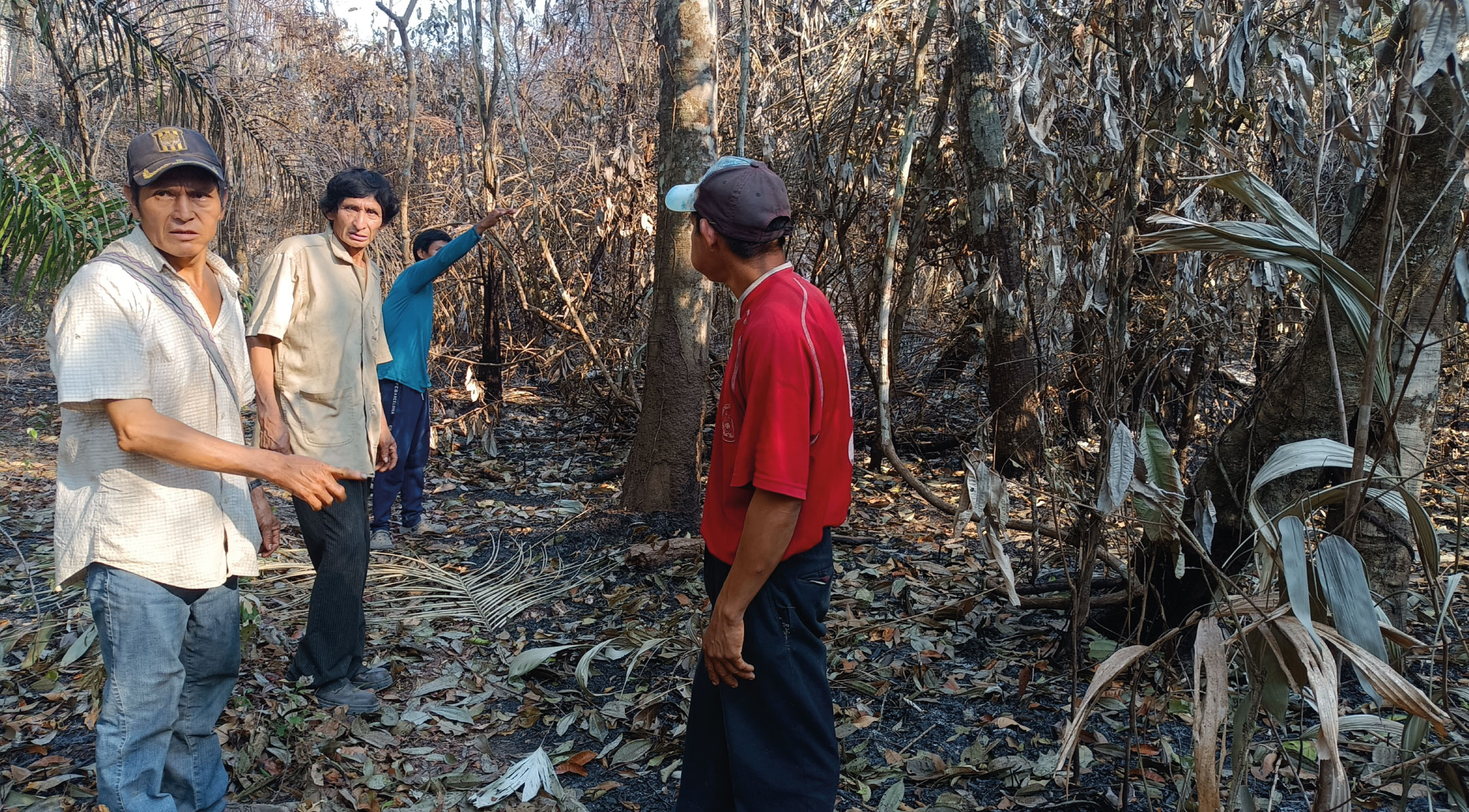Despite the resistance of community members, fires have devastated Indigenous territories and protected areas in the Bolivian Amazon. The fires have affected their food sources, access to clean water, and destroyed their homes. Beyond climate change, the issue is also structural: the government implements national policies that promote extractive economies. Now, communities know that fires will be a new excuse to encroach on their territories. The challenge of how to rebuild life, rethink traditional practices, and reclaim ancestral knowledge after the fires persists.
Despite the resistance of community members, fires have devastated Indigenous territories and protected areas in the Bolivian Amazon. The fires have affected their food sources, access to clean water, and destroyed their homes. Beyond climate change, the issue is also structural: the government implements national policies that promote extractive economies. Now, communities know that fires will be a new excuse to encroach on their territories. The challenge of how to rebuild life, rethink traditional practices, and reclaim ancestral knowledge after the fires persists.
"We are like newcomers" is the phrase heard repeatedly among Tacana, Uchupiamona, T'simane, and Moseten community members who suffered during wildfires in the provinces of Abel Iturralde (La Paz) and José Ballivián (Beni) in the Bolivian Amazon. The scene is devastating. The once-green hills are now black and brown, animals unable to escape the flames are visible amidst the ashes, and indigenous families’ plantations are charred. In the last two months, Indigenous communities in the area have lost their forests, family plots (known as "chacos" in Bolivia), and some homes made of jatata leaves.
The scale of the fires was unprecedented for the entire population. Elderly residents of San Buenaventura and Rurrenabaque who are native to the area, had never experienced a situation like this with fires. Exceptional circumstances like the exceptionally high temperatures this year and severe drought facilitated the spread of flames. Tension only eased, in recent days, when much-awaited rain allowed people to put away the machetes they were using to create fire barriers. At the end of the dry season, rain is the only means to prevent fires from reaching communal and urban areas.
Once the fires are extinguished, concerns shift. Indigenous families do not know how they will feed themselves or the impact of losing crops, plants and animals. The start of the rainy season raises fears of potential floods or the arrival of new pests due to the environmental disruption caused by the fires. Currently, communities don't know where to source water as their springs diminish and become contaminated. In the medium term, they are aware that new projects will be "sold" to them in the name of economic recovery, bringing fresh pressures on their territories. However, the persistent question remains: what can be done to avoid facing the same situation of wildfires every year?
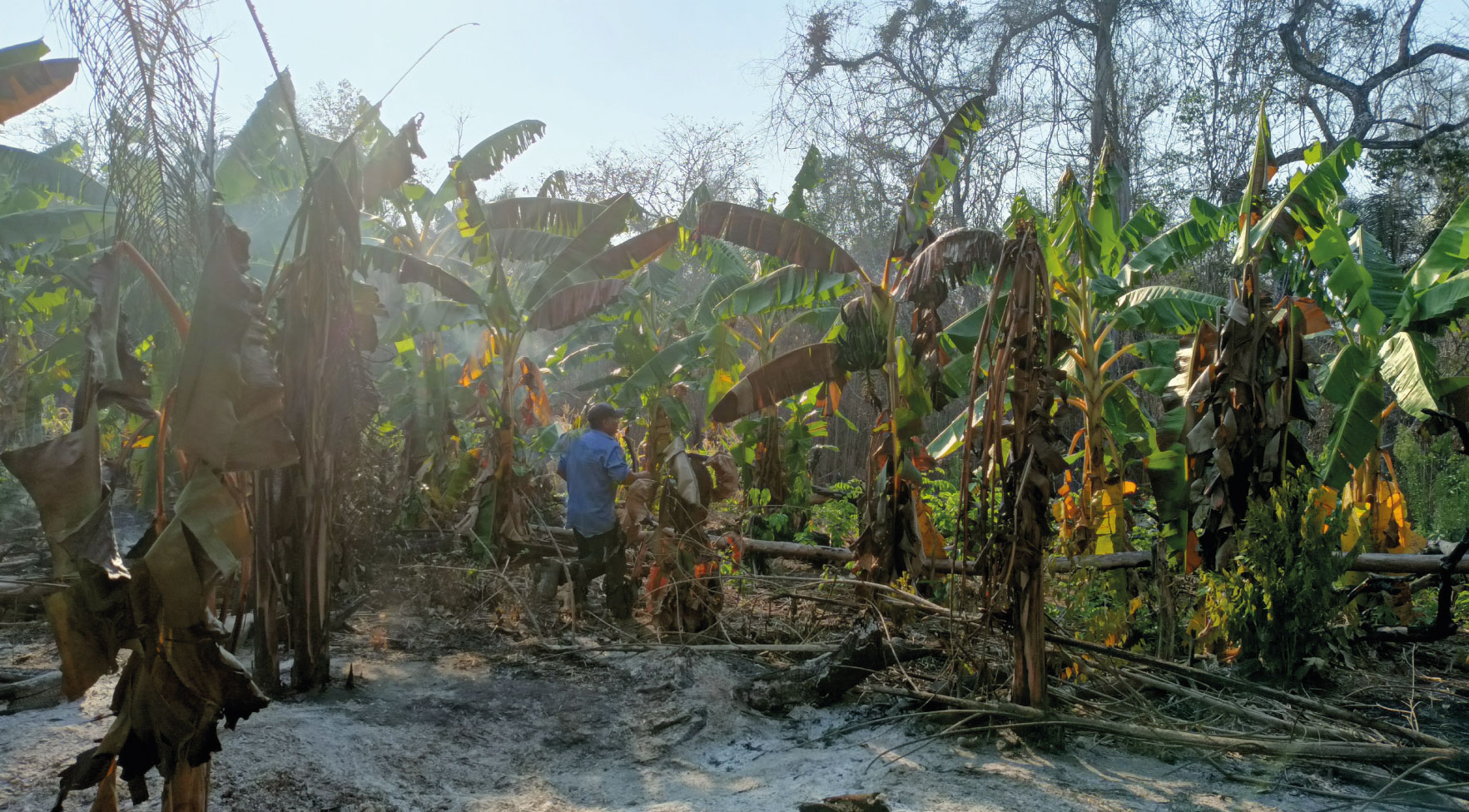
Community member surveying his burned banana plantation. Photo: Daniela Vidal
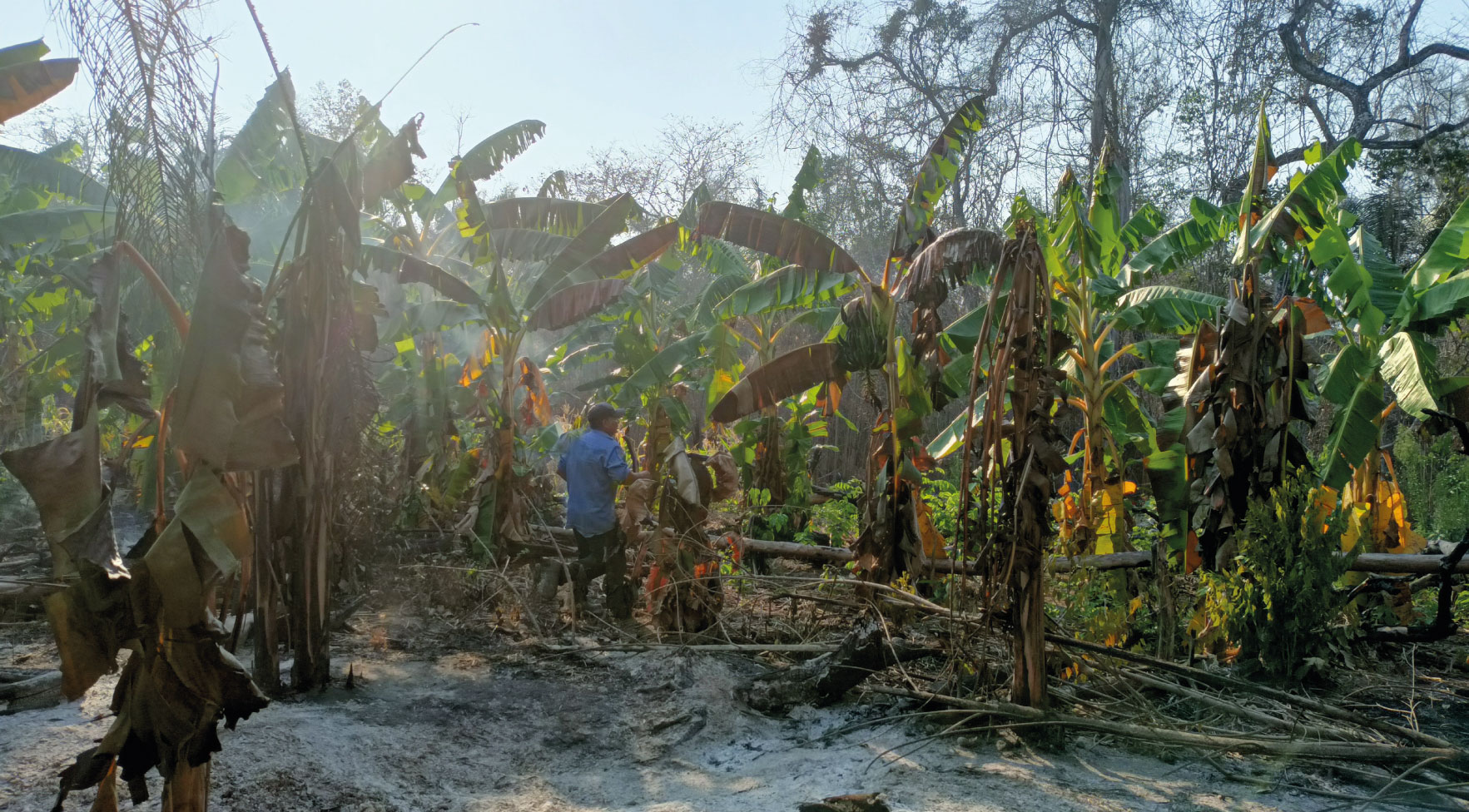
Community member surveying his burned banana plantation. Photo: Daniela Vidal
Indigenous territories and protected areas are the hardest hit
In the Bolivian Amazon, four Indigenous territories belonging to the Central de Pueblos Indígenas de La Paz (CPILAP) were severely impacted by wildfires. The Tacana territory is accessed via the San Buenaventura-Ixiamas road and the Beni River. Of its 23 communities, 11 were forced to fight the fires. In Buena Vista, the intensity of the fire surpassed the capacity of community members, firefighters, volunteers, and park rangers, who couldn't prevent the fire from reaching residential areas and consuming five houses. Children and elderly individuals had to be evacuated as the situation worsened.
In the following days, residents of Altamarani and Tres Hermanos also had to be evacuated by river. They were threatened because the sugar cane fields of the state-owned Azucarera San Buenaventura, a mill owned by the state, provided fertile ground for the fires to spread. The infrastructure of the company itself was also at risk. Across the river, in the communities of Villa Alcira and San Miguel del Bala, the main concern was preventing the fire from reaching areas designated for community tourism—a source of alternative income to agricultural product sales.
The Pilon Lajas Biosphere Reserve and Indigenous Territory has 23 communities of Tacana, T'simane, and Moseten people, accessible via the Rurrenabaque-Yucumo road and the Beni and Quiquibey rivers. At least 19 of these communities were affected by the fires. In Carmen Florida, the municipality of Rurrenabaque made great efforts to combat the fire to prevent it from reaching the water intake infrastructure that supplies the entire urban area. The community of 2 de Agosto, known for its yuca production, lost all of its crops, and likewise, the community of San José de Canaán saw its cocoa plantations burn, despite efforts to extinguish the fire day and night.
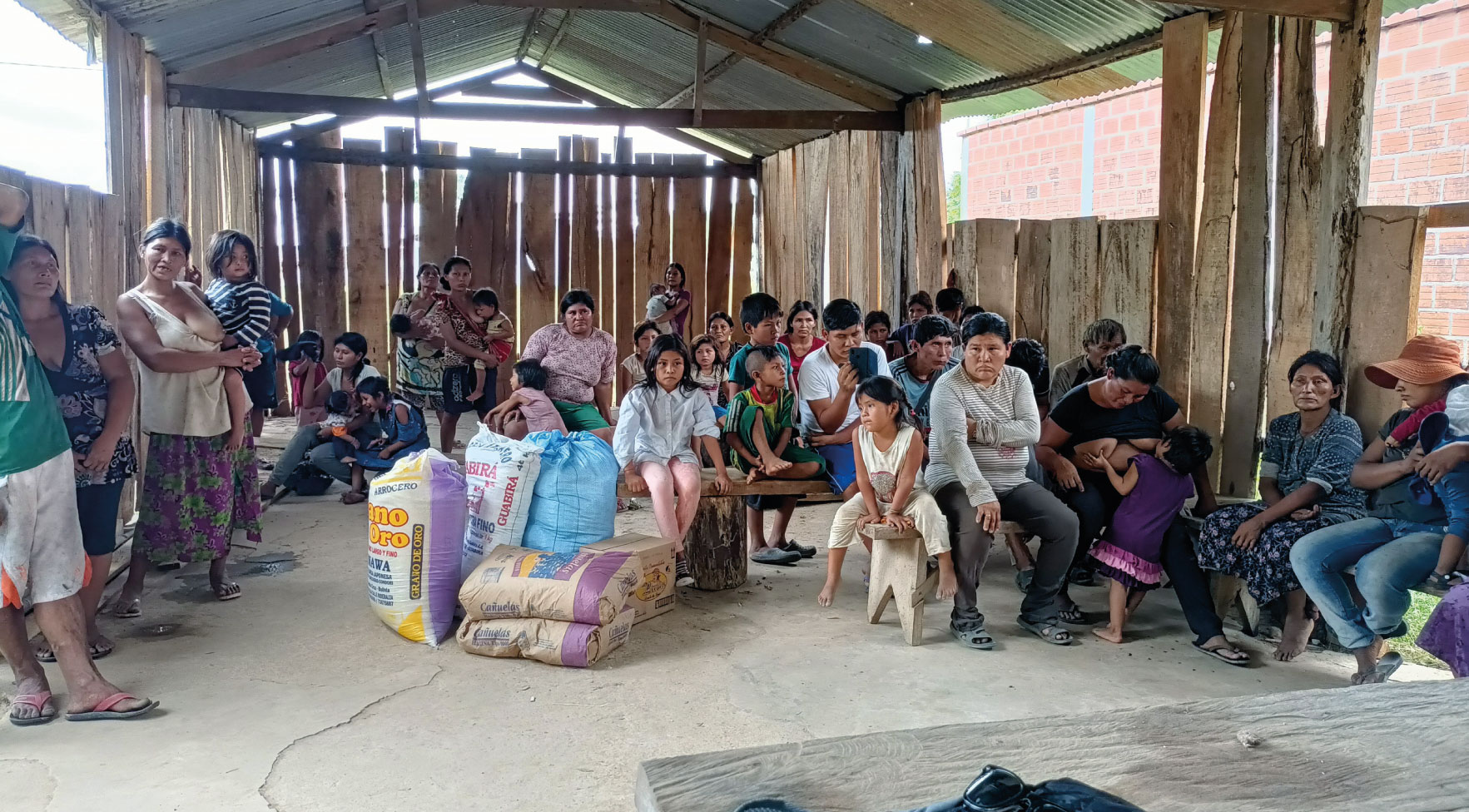
T'simane Bajo Colorado community meeting with the leadership of the T'simane Moseten Regional Council to discuss the situation of the fires. Photo: Daniela Vidal
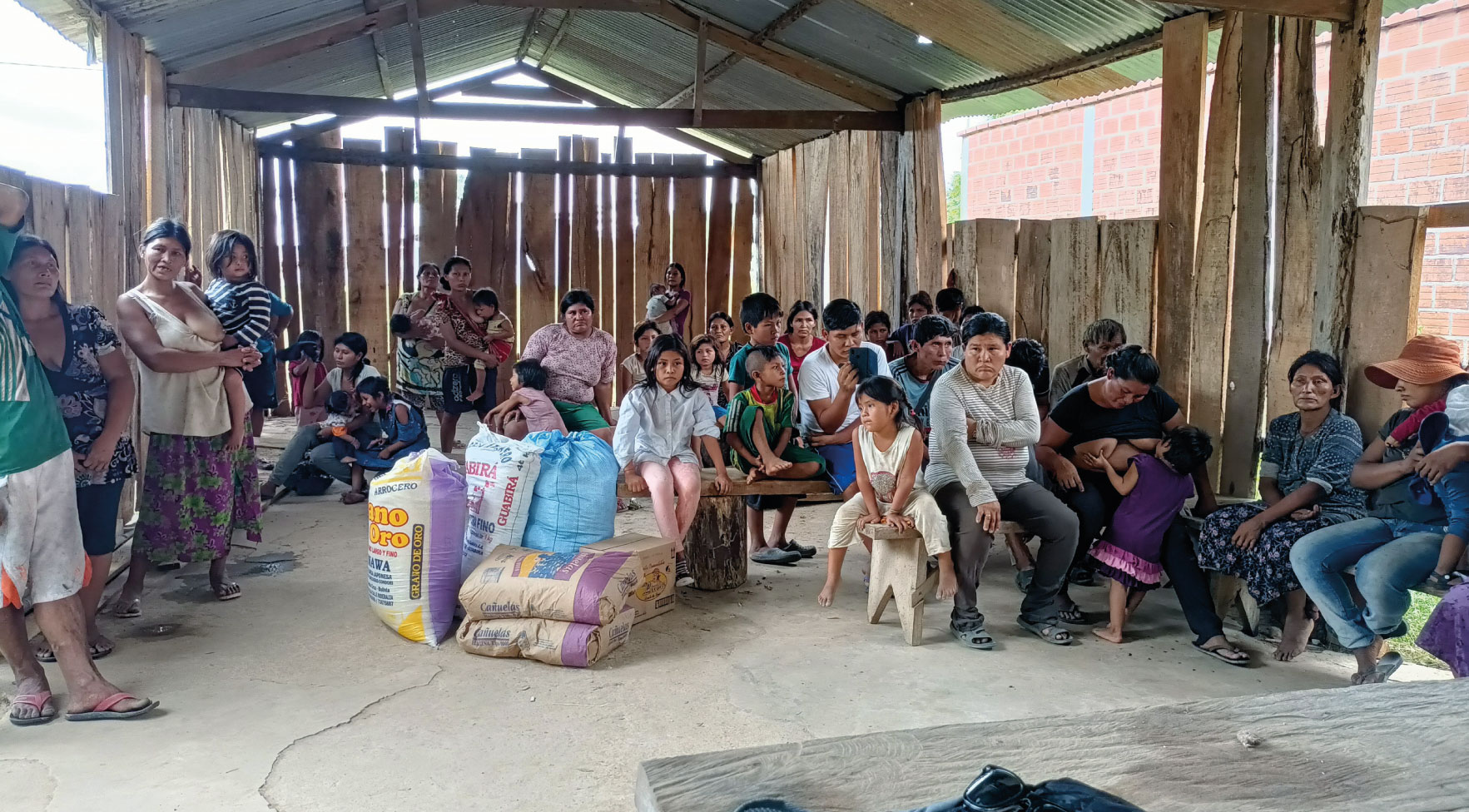
T'simane Bajo Colorado community meeting with the leadership of the T'simane Moseten Regional Council to discuss the situation of the fires. Photo: Daniela Vidal
Loss of crops and impact on community tourism
The San José de Uchupiamonas territory, located in the heart of the Madidi National Park and Integrated Management Natural Area, has a single community whose population was very close to being overtaken by fire. Park rangers and community members faced the fire under extremely adverse conditions without water and using makeshift tools. They were practically alone in the fight, due to their distance from the urban area and other emergency situations occurring simultaneously in multiple points of the region.
San José de Uchupiamonas is nationally recognized for the ethno-cultural ecotourism it has promoted for over 20 years as a territorial management strategy. In the area, there are seven tourism ventures: one community-based and six family-based. During the fires, at least one of them was at risk of the fire reaching its lodge cabin area. The impact of the fires resulted in a significant drop in visits during the months of the emergency.
Without crops to harvest and collect, without forests to hunt in, and without water to catch fish in, the situation of the T'simanes in the Yacuma sector is alarming.
Without crops to harvest and collect, without forests to hunt in, and without water to catch fish in, the situation of the T'simanes in the Yacuma sector is alarming.
T'simane people who live in the area between the municipalities of Rurrenabaque and San Borja wish to claim the Ya’cama territory. They are considered a population at high risk. Since 2016, they have been fighting to consolidate their ancestral territory, which they dispute with the intercultural sector (as the highland peasants settled in the east since the 1980s are called). There are 14 communities facing legal uncertainty ranging from conflicts about their lands, access from the road to their communities, the absence of health and school services, as well as a lack of access to potable water sources.
In addition, they have experienced the loss of their crops and forests due to uncontrolled fires that started in neighboring properties and travelled into their territory. During a walk from the Palmira community to the Yacuma River, a community member said while looking at the burned forest, "And now? Where did the animals, the bees go? What are we going to eat?" Without crops to harvest and collect, without forests to hunt in, and without water to catch fish in, the situation of the T'simanes in the Yacuma sector is alarming.
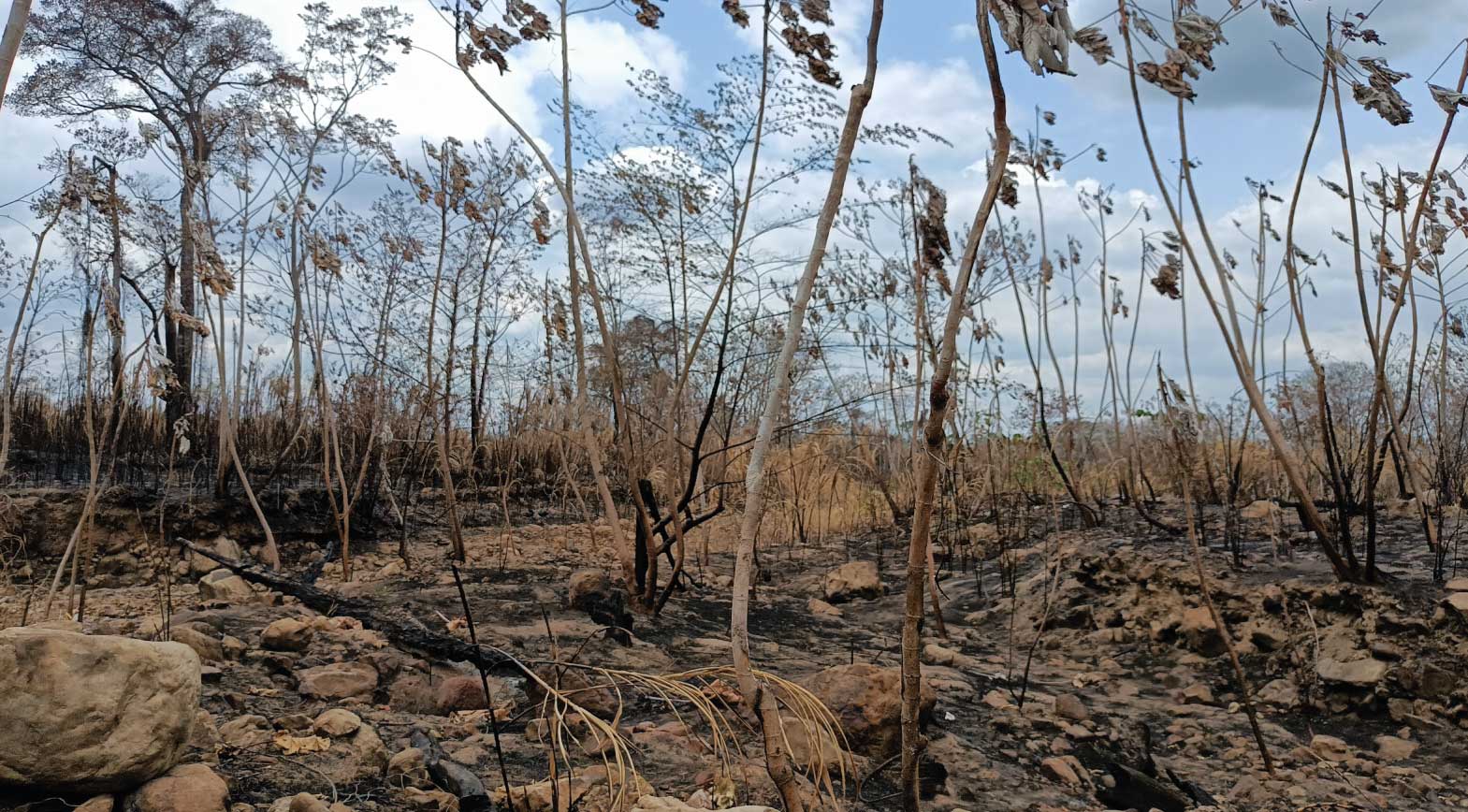
Burned area in the Pilon Lajas Biosphere Reserve and Indigenous Territory on the way to the T'simane community of 2 de Agosto. Photo: Daniela Vidal
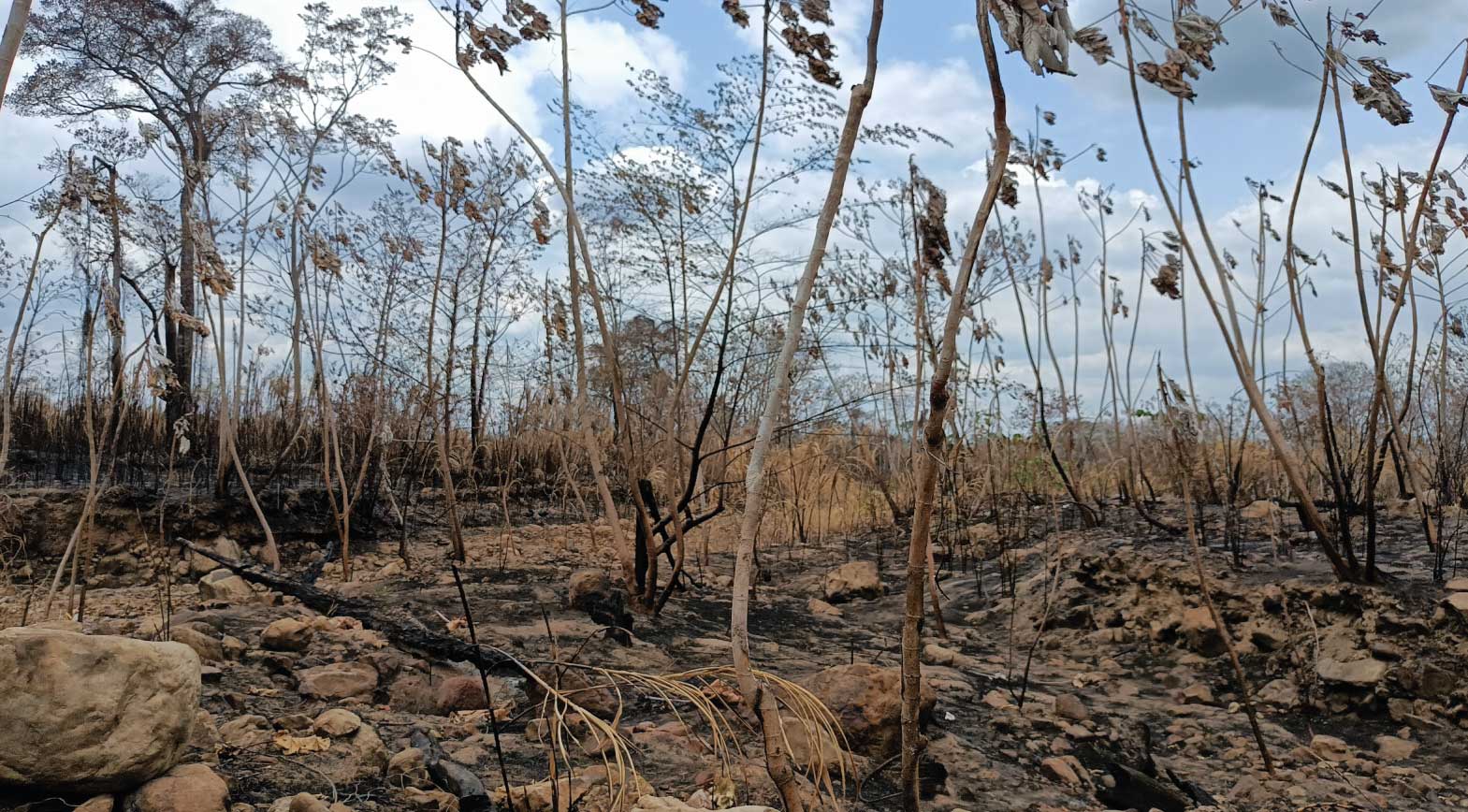
Burned area in the Pilon Lajas Biosphere Reserve and Indigenous Territory on the way to the T'simane community of 2 de Agosto. Photo: Daniela Vidal
"We've never seen anything like this before"
In 2019, Bolivia faced its largest forest fires on record, affecting more than 6,000,000 hectares of the Bolivian east, mainly in the Chiquitano dry forest in the district of Santa Cruz. That year, the “incendiary norms package", a series of laws and decrees approved between 2013 and 2019, that promote deforestation and relax permits for slash-and-burn agriculture were debated. In fact, the “incendiary norms package" is one of the causes of the annual forest fires in the country.
In 2020, following changes made to the Beni Land Use Plan (PLUS), the adaptation of these instruments, through which certain sectors seek to legalize deforestation and change the category of lands with the aim of opening the way for the expansion of livestock and extensive monocultures was noticed. Since the approval of the PLUS in Beni, there has been an increase in hotspots in the department.
In the midst of this climate crisis, questioning national norms and policies that promote extractive economies and are linked to forest fires is imperative.
In the midst of this climate crisis, questioning national norms and policies that promote extractive economies and are linked to forest fires is imperative.
Add to this, is the fact that climate change is already a reality. In October, the National Meteorology and Hydrology Service recorded exceptionally high temperatures in at least five departments. By early October, about 105 municipalities in Bolivia had declared a disaster due to the lack of rain. The combination of high temperatures and drought not only caused the loss of agricultural crops in Indigenous communities but also left the forest very susceptible to fire. The traditional agricultural technique of slash-and-burn, that was once controllable caused unprecedented fires in the provinces of Abel Iturralde and José Ballivián during this time.
In the midst of this climate crisis, questioning national norms and policies that promote extractive economies and are linked to forest fires is imperative. In 2022, Bolivia was already the third country with the highest deforestation of tropical primary forests in the world. Alluvial gold mining has seen exponential growth in the Bolivian Amazon in recent years, causing deforestation through illegal breaches, changes in river courses, and mercury pollution. At the same time, the "march to the north" promoted by President Luis Arce Catacora seeks to consolidate road projects in the northern Amazon without complying with environmental regulations and to promote monocultures of corn, rice, sugarcane, soy, and oil palm.
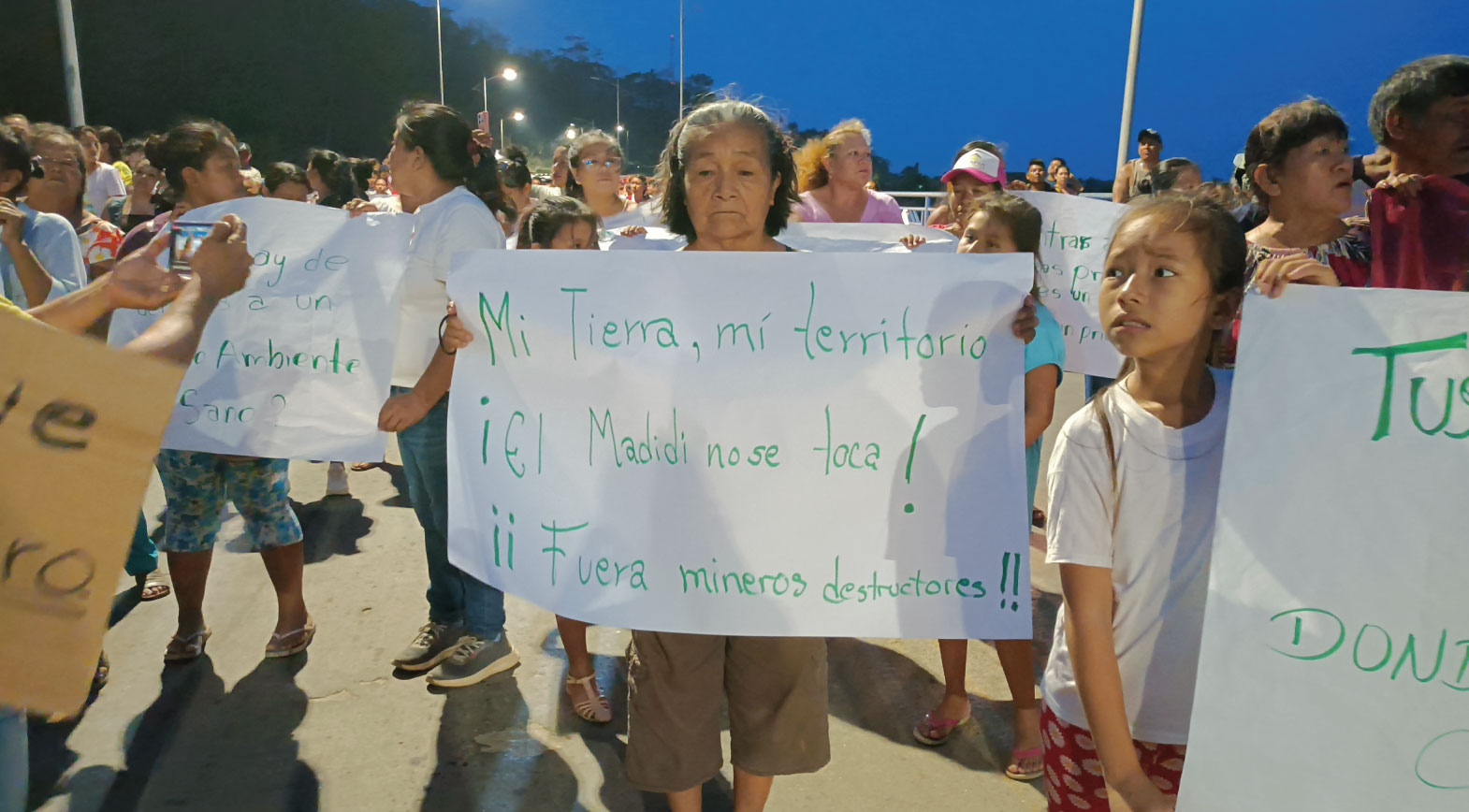
March from San Buenaventura to Rurrenabaque against mining and forest fires. Photo: Daniela Vidal

March from San Buenaventura to Rurrenabaque against mining and forest fires. Photo: Daniela Vidal
What comes after the fires?
Indigenous Peoples are aware that pressures on their territories will increase in the short term. The vice president of the T'simane Moseten Regional Council, Magalí Tipuni, expressed her sadness about the over burned areas. "Here, they wanted to build the El Bala megadam so much that we defended the territory and now the fires came and devoured us." A Tacana chief also shared his anger at the state's neglect: "They want to suffocate us to force us to give up our territories, but we won't give in. We will defend our water and our Madidi Park."
Indigenous leaders fear that the vulnerability of their communities will be used to misinform, manipulate, and impose agricultural projects based on monoculture. Something similar had already happened when the San Buenaventura Sugar Company was established, which promoted the clearing of the forest in neighboring communities to plant sugarcane. There is also the risk of increasing conflicts due to encroachments on their territories and protected areas that were ravaged by fire.
Indigenous Peoples, once again, are facing the tremendous challenge of rethinking traditional practices. They have the additional challenge of figuring out how to combine these with new techniques of sustainable production and the protection of common goods.
Indigenous Peoples, once again, are facing the tremendous challenge of rethinking traditional practices, rescuing and protecting ancestral knowledge.
In terms of the rebuilding of life in the territory, the main concerns are the food insecurity of Indigenous families, the reduction or contamination of their water sources, and potential imbalances caused by the loss of wildlife and vegetation. In the face of these concerns, the right to food and water, and the rights of Nature are crucial and will be at the center of the demands of affected Indigenous organizations.
Finally, Indigenous Peoples, once again, are facing the tremendous challenge of rethinking traditional practices, rescuing and protecting ancestral knowledge. They have the additional challenge of figuring out how to combine these with new techniques of sustainable production and the protection of common goods that will allow them to be resilient in the face of the current climate crisis. They know very well that, beyond the losses they suffered during the recent fires, the defense of life and the "great house" is a long and essential battle for future generations.
